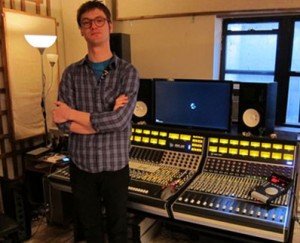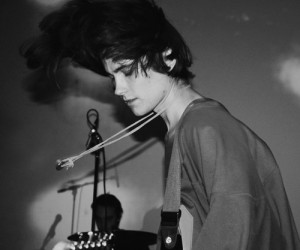The Best of Both Worlds: Mid-Fi Recording with DIIV & Daniel James Schlett
Daniel James Schlett is probably one of the best engineers I know under age thirty. I don’t say this because he works out of one of my favorite studios, Brooklyn’s Strange Weather Recording, but in spite of it. The more work he gets, the harder it is for me to book the place for myself.
Schlett is barely past twenty-five, tall and lanky with an easygoing smile and a penchant for inconspicuous dabs of fluorescent color in his wardrobe. He has an affinity for gritty world music, obscure Vangelis b-sides, incomprehensible noise-rock and gratifying dub flourishes. He’s also a veritable dinosaur connoisseur, with a tattoo of a stegosaurus on his left arm.
A couple months ago, he was busy assisting Nigel Godrich on the new Here We Go Magic album during their stint at Strange Weather. I demanded that he feed me all of the legendary Beck /Radiohead producer’s best tricks. He did, and regrettably, I’m sworn not to share any of them with you here.
When I met up with him at the studio, Schlett was just back from tour with Nerve and DJ Shadow, and in the middle of finishing mixes for the full-length debut from a band called DIIV.
They’re a group that fuses the pulse of 70s kraut-rock with the sonics of 80s new wave and puts it all through the emotional filter of a grunge-era teenager.
“Cole has a lot of hustle,” Schlett tells me about the DIIV’s frontman, Zachary Cole Smith. “He wants to play music for the time that he’s here on the planet, and he’s taken the steps to be able to do that.”
Those steps include: Playing guitar for indie darlings like Beach Fossils, Soft Black and Darwin Deez; having his first 4 tracks championed by Pitchfork; and touring the nation’s alternative-venue circuit – Relentlessly.
When I first heard DIIV, it was in a videotaped live performance at Swan7 Studios. They played as a guitar-driven 4-piece, a flurry of young faces with a cool, daydream-like sound. Live and un-produced, they seemed novel but instantly familiar, owing plenty of their heritage to early-90s underground guitar rock. In this context, the first thing you hear might be traces of Geffen-era Sonic Youth, Incesticide-era Nirvana, even Polaris – the under-recognized alterna-rock trio best known for the theme to Nickelodeon’s cult-classic TV show, Pete and Pete.
If your first exposure to DIIV is through their live music, you might be taken back, like I was, by the sound of their first self-produced EP. On it, Smith’s breezy, well-honed pop songs sound instead like charming lo-fi machinations: rock music as re-interpreted by Tears for Fears or The Cure, if they had been chained into a ramshackle home studio with a cassette 4-track and a taped-together Casio keyboard.
For the band’s upcoming full-length album, Oshin, Smith brought Schlett on board to help bridge that gap without losing any of the features that make DIIV the band that it is.
“They’re on the Captured Tracks label, which is cut more from the lo-fi cloth,” Schlett says. “This new record is what I like to call “mid-fi” – Where you make a record with a bunch of cool hi-fi audio equipment, but then push it into this territory where it’s not quite ‘glistening’ anymore. There’s a lot of heavy-handed pumping compression under the mix, a lot of distortion blended into the tracks, things like that.”
“It’s both their aesthetic and my aesthetic,” says Schlett. “If Cole had made this record on his own, it would have come out more on the lo-fi side, and if he had just gone to some random ‘studio xyz’ down the street, it might have sounded a little bit too nice.”
This is exactly what makes an engineer like Schlett perfect for a project like DIIV’s Oshin. Like so many of my favorite Brooklyn producers, he’s just young enough to want to break all the rules – and just experienced enough to know how.
“A lot of the first record was done in this tiny space by Cole with drum machines and direct guitars, which helped give [the EP] a kind of cold, electronic vibe,” he says. “I wanted to try to bring out the band behind the recordings, without losing the sound that Cole’s always had in his head.”
Schlett says there’s “still plenty of drenched-out reverbs” and “tons of tape-delay going on.” Some of his sounds even go through multiple stages of delay: “A short delay, a medium delay and a long delay, so that sound is filling every available space; every syncopation inside a rhythm.”
“Cole and I would be mixing and he’d say, ‘It’s not right yet. I want more reverb. On the whole mix.’ Or, he’d want more compression on the whole mix to a point where it would make the tracks pump and flutter. I’d sit there for a minute and say ‘I don’t know Cole, this already is where I think sounds good…’ But then you have to stop say, ‘Wait a second. I’m going to follow you on this vision a little bit. I’m going to see where you want this to go, because maybe… Maybe you’re onto something.’”
This is where it becomes clear that Schlett is a musician as much as an engineer. He’s comfortable sacrificing what seems right for what sounds right. “Maybe being more committed to a particular aesthetic, being more heavy-handed with an approach and really following that vision where it takes you – Maybe that’s what’s going to make this its own thing, instead of it just being some record that people don’t want to listen to next year.”
There’s a private battle that goes on in every engineer’s mind when they have to compromise accepted technical rules-of-thumb for the creative whims of an artist: Is this an aesthetic choice or an over-eager mistake? Do I want to make this sound a certain way for me or for them? What will other engineers think? Wait a minute – What do I think? What does the artist think?
Schlett understands this battle. He’s been in the studio enough to have some faith in his choices, and he comes out on the right side of it more often than not. Of course, even with all the confidence in the world, there are still moments of doubt.
“Sure, I mean, I listen to it sometimes against other records and I’m like ‘damn‘, you know? It’s not as ‘slicked-out’ as some other stuff you might hear on the radio. But I think that’s part of what makes this one stand on its own. At a certain point you just have to say ‘Okay, cool. Let’s do this. Let’s follow that vision.”
Stream the new DIIV song “Doused” off the upcoming album Oshin here:
Please note: When you buy products through links on this page, we may earn an affiliate commission.









Bones
May 2, 2012 at 5:47 am (12 years ago)this band actually sounds pretty good
Jim Schlett
May 8, 2012 at 12:36 am (12 years ago)One of the amazing Schlett’s
some dude
December 12, 2013 at 10:21 pm (10 years ago)daaamn i wanna intern with Schlett. it’s hard to find producers who can understand what the mood of the song might need, in spite of technical rules.
philliphuntterreed
January 14, 2014 at 10:44 am (10 years ago)So about those Nigel Godrich tricks… 😀